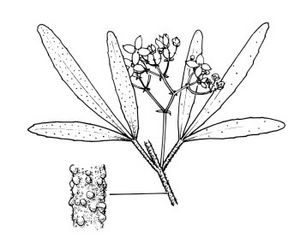Floyd's zieria facts for kids
Quick facts for kids Floyd's zieria |
|
|---|---|
 |
|
| Conservation status | |
| Scientific classification | |
| Genus: |
Zieria
|
| Species: |
floydii
|
The Floyd's zieria (scientific name: Zieria floydii) is a special plant. It belongs to the Rutaceae family, which is the same family as citrus fruits like oranges! This plant is found only in the New England Tableland area of New South Wales, Australia. It's a shrub that stands upright. Its branches are a bit lumpy and hairy. Its leaves look a bit like clover because they have three parts. When it blooms, you'll see creamy-white flowers. Each flower has four soft petals and four stamens.
Contents
What it Looks Like
Floyd's zieria is an upright shrub. It usually grows to about 2 m (7 ft) (about 6.5 feet) tall. Its younger branches have many small, wart-like bumps. These bumps, and the branches themselves, are covered in tiny, star-shaped hairs.
The leaves of the plant are made up of three smaller parts, called leaflets. The middle leaflet is shaped like a narrow oval or a spear. It is about 17–25 mm (0.7–1 in) (0.7 to 1 inch) long and about 3 mm (0.1 in) (0.1 inch) wide. The stalk that holds the leaf, called a petiole, is about 4–6 mm (0.16–0.24 in) (0.16 to 0.24 inches) long. The top of the leaflets has a few small, hairy bumps. The bottom of the leaflets is very bumpy. The main vein on the underside of the leaf is covered with those star-shaped hairs.
Flowers and Flowering Time
The flowers are creamy-white and about 4 mm (0.2 in) (0.16 inches) across. They grow in groups of 20 to 80 flowers. These groups appear where the leaves join the stem, which are called leaf axils. The flower clusters are shorter than the leaves.
Each flower has small, triangular parts called sepals. These are less than 1 mm (0.04 in) (0.04 inches) long and are also bumpy. The four petals are about 2.5 mm (0.1 in) (0.1 inch) long. They overlap each other and are very hairy. Each flower also has four stamens, which produce pollen. Floyd's zieria mainly blooms in November.
How it Got its Name
The scientific name Zieria floydii was officially described in 2002. This was done by a scientist named James Andrew Armstrong. He studied a plant sample found near Big Scrub Creek. This area is in the Guy Fawkes River National Park. The description was then published in a science journal called Australian Systematic Botany.
The second part of the name, floydii, is a special way to honor someone. It was named after Alex Floyd. He was an Australian botanist, which is a scientist who studies plants. Alex Floyd was the one who first collected the specific plant sample that was used to describe this new species. This special sample is called the type specimen.
Where it Lives
Floyd's zieria is a very rare plant. It is only found in two places: the Guy Fawkes River National Park and the Chaelundi National Park. Both of these parks are in New South Wales, Australia.
This plant usually grows on the edges of dry rainforests. Sometimes, you might also find it in wet forests or in areas with low, shrubby plants called heath.
Protecting Floyd's Zieria
Sadly, Floyd's zieria is an "Endangered" species. This means it is at high risk of disappearing forever. It is listed as endangered under laws in New South Wales and also under a big Australian government law called the Environment Protection and Biodiversity Conservation Act 1999 (EPBC) Act.
There are several things that threaten this special plant:
- Fires: Fires that happen too often or at the wrong time can harm the plants.
- Grazing: Wild goats (Capra hircus) eat the plants, which stops them from growing and reproducing.
- Land Clearing: When land is cleared for other uses, the places where Floyd's zieria grows are destroyed.
Protecting these areas and managing these threats is very important to help Floyd's zieria survive.


